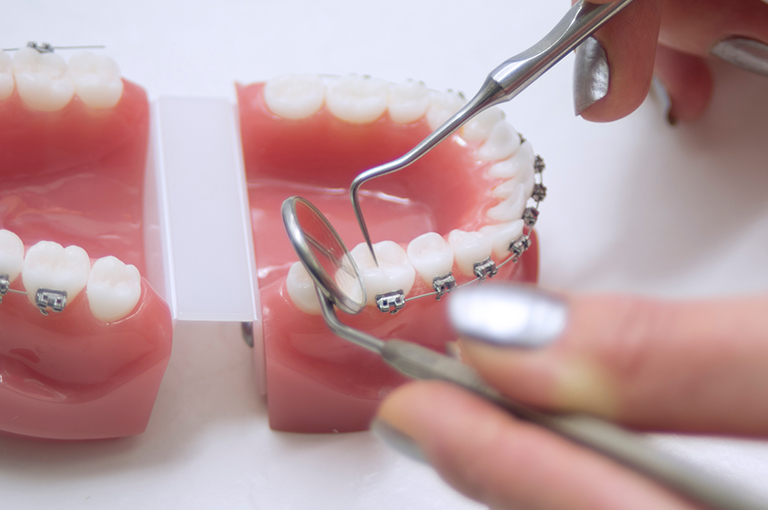Denture retention means

Retention is the resistance to the displacement of the prosthetic base vertically, or contrary to its insertion axis. When the prosthesis is offset against its insertion axis, it loses retention.
Stability is the resistance that the prosthesis will have by lateral forces, lateral displacement, or oblique forces that tend to displace the prosthesis on the horizontal axis.
The total prosthesis (upper or lower) is supported on the rim, in the mucosa and there are established phenomena that will justify its retention and stabilization. These phenomena that justify the retention of the total prosthesis can be physical, physiological, psychic, mechanical, chemical or surgical.
Physical Phenomena
Physical phenomena occur directly between the base of the prosthesis, the inner part of the prosthesis and the patient's mucosa. Physical phenomena are mediated by saliva that interposes between the base of the prosthesis and the mucosa.
Adhesion is a physical force that involves attracting different molecules. Molecules other than prosthesis and mucosa by saliva film.
- Cohesion is the force of resistance between the molecules of the same material, in this case, between the molecules of saliva itself, because when the prosthesis tends to move, the saliva molecules stay together so that the salivary film does not break. .
- Surface tension occurs in the region where the prosthesis edge joins with the mobile mucosa region of the buccal sulcus bottom. The saliva film that lies between the mucosa and the edge of the prosthesis prevents air from penetrating, maintaining internal saliva pressure and maintaining cohesive force. If the surface tension is lost and this peripheral sealing, air will enter and the prosthesis will fall, because it will lose the adhesion and cohesion forces.
- Atmospheric pressure has less influence than the previous ones. It is related to the weight of the atmosphere on the earth's surface. When a patient has the prosthesis in the mouth (speaking, walking) the external pressure equals the saliva film pressure, but when forces tend to displace the prosthesis, the external pressure becomes greater than the saliva film pressure. , and as this external pressure increases, the saliva film pressure will rupture. The good thing is that every time the external pressure increases, the cohesive and adhesive forces will act to prevent displacement of the prosthesis and disruption of the saliva film. In patients with low salivation, it is difficult to keep the prosthesis retained in the mouth, precisely because these adhesion and cohesion forces cannot be achieved.
Physiological Phenomena
Physiological phenomena depend on the rim configuration, neuromuscular control and the amount of saliva in the patient.
- The configuration or shape of the residual edge greatly influences the retention of the prosthesis. A heavily absorbed residual rim, with little bone for example, will not have enough area to retain the prosthesis, and will have poor retention. The greater the bone volume, the crest, crest and ridge strands, the greater the retention. Sometimes there are bulky edges, rich in bone but with a lot of soft tissue, which makes retention difficult. The rim can be high, normal or short (with reabsorbed rim not good).
- Neuromuscular control is the adaptive capacity of the patient who will be wearing a full denture. Some patients adapt faster than others who have more difficulty adapting, because around the place where the full denture is inserted there are several muscle insertions that tend to displace the rim prosthesis. At first the muscle insertions will displace the prosthesis when the patient speaks, opens his mouth, smiles, yawns; but the patient will have to relearn how to limit these movements and adapt to that limit. Over time this patient will acquire a reflex arc and exercise these (more limited) movements without realizing it. For this reason, the patient who is a full denture user can better adapt to the new prosthesis, having already acquired these reflexes, while the one who never used will have to go through the whole process of adaptation to the total prosthesis.
- The amount and quality of saliva also influences the retention of total prosthesis. Patients with too much saliva can be a problem because too much saliva helps to lose adhesion, the same for those with saliva deficiency, since peripheral sealing will be lacking, and adhesive and cohesive forces will not occur to retain the prosthesis. The ideal quality of saliva is fluid and serous; viscous, thick saliva may hinder molding.
Psychic Factors
Psychic factors classify the patient into three types. Receptive patients who always collaborate for the success of the treatment. Skeptical patients who need to gain confidence at work to feel safe. Indifferent and negative patient, the most difficult to deal with, often does not even want treatment, does for other reasons. Probably in the latter case treatment failure occurs.
Mechanical Factors
Mechanical factors in the assembly of upper and lower teeth, which relate to each other and that it is possible to establish a bilateral balanced occlusion to maintain the retention and stabilization of the prosthesis. If the mechanical mounting of these teeth is not within bilateral balanced occlusion, retention or stabilization may occur.
Chemical Factors
Chemical factors are other means that help retain the prosthesis through products such as pastes, adhesives, among a few other similar products.
Surgical Factors
In the past, when there were no implants, surgery was often used to increase the basal area and, consequently, increase the retention of the total prosthesis. This procedure has fallen out of favor due to its failure rate. With bone-integrated implants it is possible to integrate any type of jaw, even those with the least amount of bone.
Source: Profissão Dentista. Available at: https://profissaodentista.com/2017/01/23/meios-retencao-protese-total/. Access on: 08/24/2020.
imagem: twenty20photos, de envatoelements
